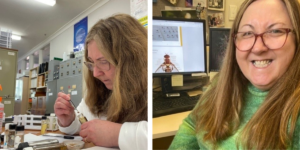This month we shine the spotlight on Nancy Cunningham, a Senior Entomologist at the South Australian Research and Development Institute (SARDI), part of Primary Industries and Regions, South Australia (PIRSA).
Nancy manages the Waite Insect and Nematode Collection (WINC) and works on fruit fly response and biosecurity surveillance. She specialises in Dermestidae and Tephritidae taxonomy, and is passionate about the importance of reference collection.
How did you find yourself on this career path?
I majored in Zoology at university and did some entomology subjects on the side at the Waite Campus of the University of Adelaide, but I had no idea when I finished studying that I would end up back at the Waite! I had enrolled in postgraduate studies in Natural Resources Management but after I finished, I found myself in a casual job working for Primary Industries. The Entomology group wasn’t part of SARDI then but moved into the research area within a couple of years of me working for them! I started in a technical role but moved into a research role in 1999.
How long have you worked in this area?
I’ve been working for the entomology group since 1994 in various technical and research positions.
What taxa/taxon do you specialise in, if any?
I specialise in Dermestidae and since last year have moved onto dipteran taxonomy, particularly Tephritidae.
What does a typical workday look like for you?
Usually, the day starts with a team meeting regarding tasks we want to achieve for the day. At the beginning of the week, I like to whiteboard my tasks and tick them off as they’re completed. Later in the day I’m usually involved with checking off on fruit fly response tasks, including identification and official recordkeeping. Once a week I put aside an afternoon to work on the collection — this is something I have only just started doing. As part of my role as fruit fly entomologist, I have a small project looking at ensuring our collection specimens are curated correctly and that the database, which we have recently migrated from an Excel spreadsheet to eMuseum, is up to date.
What do you enjoy most about working in this area?
I really love the curation aspect of working as the WINC manager — getting to know all facets of the collection and learning new aspects of species I’m not familiar with. I love using the collection as a means to identify insects that come in through our diagnostic services.
What do you find most challenging about working in this area?
We lack resources to spend time in the collection, so finding time ‘between the cracks’ of other project work and biosecurity activities is definitely a challenge.
What is your most memorable career achievement?
Moving into a research role from a technical role and being recognised for that within SARDI, as well as outside the organisation by peers and industry leaders.
What advice would you give anyone who is unfamiliar with plant pest/pathogen reference collections and wants to use their services (e.g. specimen deposition, diagnoses, loans)?
Everything I have learned about the collection and associated taxonomy of pests has been an ‘on the job’ process. Even with entomology training it’s hard to get a feel without the practical knowledge gained by interacting with a working collection. So, my advice is to speak with collection managers about what we do, what it involves and how to use it, and if they’re interested, how they can get involved (even as a volunteer!).
Links to professional profiles
LinkedIn
ORCID
Research Gate
Organisation profile: South Australian Research and Development Institute (SARDI)
